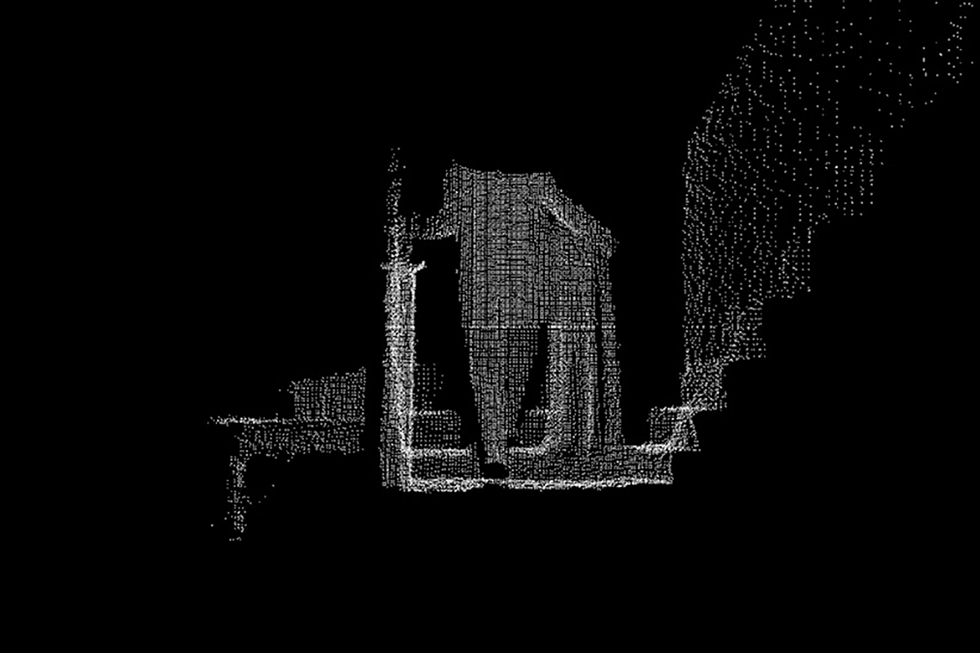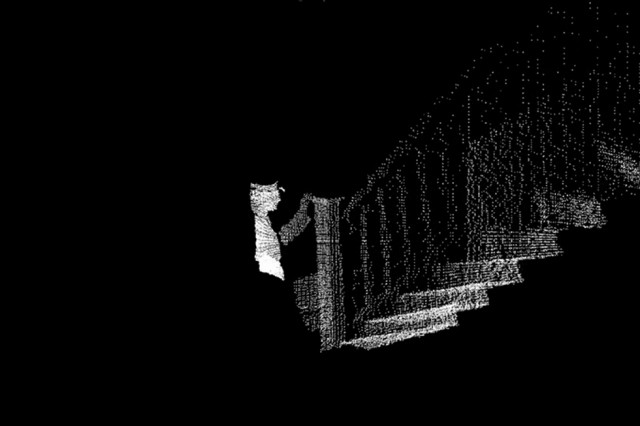“Frightening with its familiarity”: Shadow Worlds | Writer’s Rooms — Freud’s House Reviewed

Hannah Elizabeth Allan finds an uncanny domestic space at The International 3 gallery: where the familiar is transformed into the sinister…
Overwhelming the small, white-walled gallery of International 3, a pair of large-scale screens display a haunting, mirrored, moving image. The inverted angle of the projection creates an inhabitable space, one that seems to be constantly slipping away from us. This sense of immersion is further increased through the audio that accompanies the work. Recorded for headphone playback, the binaural soundtrack creates the illusion of a 3D space, where the echoing footsteps, distorted noise and creeping whispers surround and create an environment for both audience member and work to exist within.
Using interdisciplinary methods, Brass Art’s Shadow Worlds | Writers’ Rooms – Freud’s House exhibition records a series of interactions within the domestic spaces of now absent writers. It emphasises the haunted quality of time spent as artists in residence at the Freud Museum, London, having been commissioned in 2014 by the University of Salford.
The UK-based arts collective have, in this multi-sensory installation, continued their innovative means of combining performance and technology to re-interpret spaces, creating new perspectives on the seemingly familiar. With a particular focus on body and environment, and use of Kinect scanning technology, Brass Art set out to track the eerie, uncanny qualities of this domestic environment during their occupation of it.
Brass Art are made up of artists Chara Lewis, Kristin Mojsiewicz and Anneke Pettican, based in Manchester, Glasgow and Huddersfield, who have worked within a collaborative framework since 1999. Recent work has included an earlier Shadow World’s residency at the Bronte Parsonage, resulting in the exhibition The Imagining of Things at Huddersfield Art Gallery (2013). Other exhibitions include Flights of Fancy Tatton Park Biennial, Cheshire (2012), with work also shown at the Whitworth Gallery, Manchester and Yorkshire Sculpture Park.
Made on residency at the family home of Sigmund Freud, where modern psychiatry was arguably founded (it still houses that famous, well worn, much parodied couch), the resulting new work unfolds as a telling of the domestic as something other, from under the skin of the physical space, engaging with the embodied memories of past and future occupants. This allows for a detailed, performative exploration of the selected writer’s domestic space, similar in tone to the initial work set in the context of the Bronte Parsonage.

It is an intense experience to stand as a viewer and be enveloped by this Freudian space with all of its history, refrains and layering of place-upon-place; and a sensation only emphasised by the use of headphones isolating you from fellow audience members. The immersive nature of the binaural audio track (mapped onto the ‘real’ space depicted within the film, creating a 3D soundscape), further adds to this sense of transportation from the gallery to the subverted space of the home.
Crafted in Brass Art’s Freud’s House is an experience somewhere between vertigo and déjà vu, where tumbling scenes and snatches of melody leave a guttural imprint, one that is familiar yet distanced through the halting and uncertain narrative of the piece. Enveloped by the work, you might become entranced within the shifting textures, only faintly aware of where scenes repeat and transition into each other for the second or third time around.
Freud’s House repeats itself, with recognisable gestures and movements acting as refrains within the flow. Instead of feeling a distinct beginning and end to the work, an impression is given of the same echoes of events mirrored endlessly. A fractured, looping narrative is created. The figure we assume to be Sigmund Freud walks the corridors and stairs of the house, yet the face is invisible to us, an eerie blank space. Only the hat and silhouette of the psychiatrist make him recognisable, the stance offering a sense of command and ownership. A female figure is represented by a skirt first animated and dancing, then dropped as an empty garment. These gendered gestures and motions through the domestic space are replayed back to us: as detached and deteriorating black and white pixelated loops.
For all its sense of the uncanny, Freud’s House speaks of unheard histories that lie beneath the surface of these institutions; perhaps, we feel that this is the space as experienced by that anonymous female figure: barely glimpsed, yet haunting the work. The feminine object of the skirt — and the performer inhabiting it — transforms into Freud’s daughter Anna, working in the shadow of her father in this house; or a patient performing the role of an anonymous woman’s voicelessness within a male dominated, domestic-psychiatric space.
With this installation, Brass Art have added their voices to the narrative of the Freud house. Many previous narratives come to mind, including generations of the Freud family, the history of psychoanalysis, and the balance between male and female control of the home – they all loom within the shadowed landscape. This is a work that seeks to literally invert the physical space of the domestic through contemporary technology, in order to reveal the complex relationships between the renowned inhabitants and the structure itself.
The performing figures appear trapped and fated to replay scenes within this domestic setting undone by the artists. They act as our tether to that original version: the home-turned-museum. It now becomes altogether stranger and more sinister; the airy white, high-ceilinged rooms are replaced with dark corridors and unrecognisable soundscapes. So, these characters return us to the narrative; yet also embody a sense of the space haunted by inhabitants who yearned for another place or time. They are present, yet as the camera angle twists outwards, they themselves become negative space, existing in a liminal state within this version of the home. As an audience, we might begin to question if this skeletal ‘other’ is in fact the reality that which lies beneath the polished, curated museum we can enter today.
Freud himself wrote within his essay on The Uncanny about the potential liminality of the domestic space: that which seemed familiar transformed into the sinister, where nothing has changed, apart from perhaps the perception of the viewer. As Freud wrote, the “uncanny is what one calls everything that was meant to remain secret and hidden and has come into the open” (Sigmund Freud, David McLintock, and Hugh Haughton, The Uncanny, New York: Penguin Books, 2003, pp132) and with this work we begin to glimpse that alternative vision of the home. Freud’s House exemplifies this notion of the uncanny. Having occupied The International 3 space, Brass Art have gone on to modify and re-double it as a family home, highlighting the family’s palpable absence, and replacement with doppelgängers or relics. The domestic has become an unknown place, looming and frightening with its familiarity.
Hannah Elizabeth Allan
This article has been commissioned by the Contemporary Visual Arts Network North West (CVAN NW), as part of a regional critical writing development programme funded by Arts Council England — see more here #writecritical
Brass Art’s Shadow Worlds | Writers’ Rooms – Freud’s House was at The International 3, Manchester, from 18 September to 30 October 2015. Their next exhibition (title TBC) will be a curated group show of 2015 fine art graduates; preview Friday 11 December 6-8pm. Exhibition continues 12 December-29 January 2016
See a second iteration of Freud’s House at Thought Positions in Sculpture, curated by Dr Rowan Bailey, at Huddersfield Art Gallery: Friday 16 October 2015-Saturday 9 January 2016
More from the artists: brassart.org.com
Images: Brass Art, Shadow Worlds | Writers’ Room — Freud’s House, 2015. Courtesy the artist and The International 3





